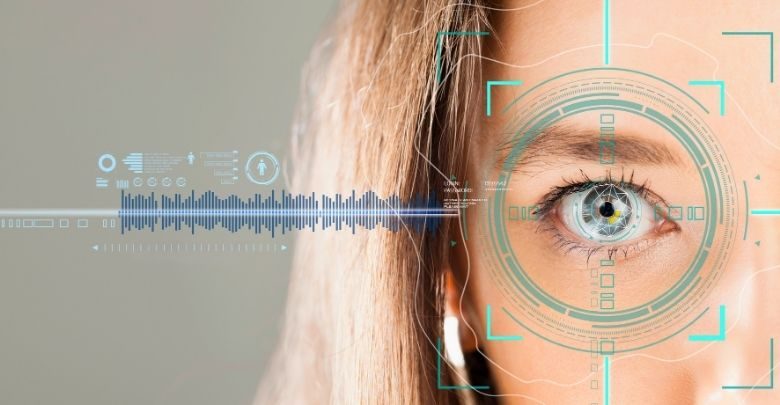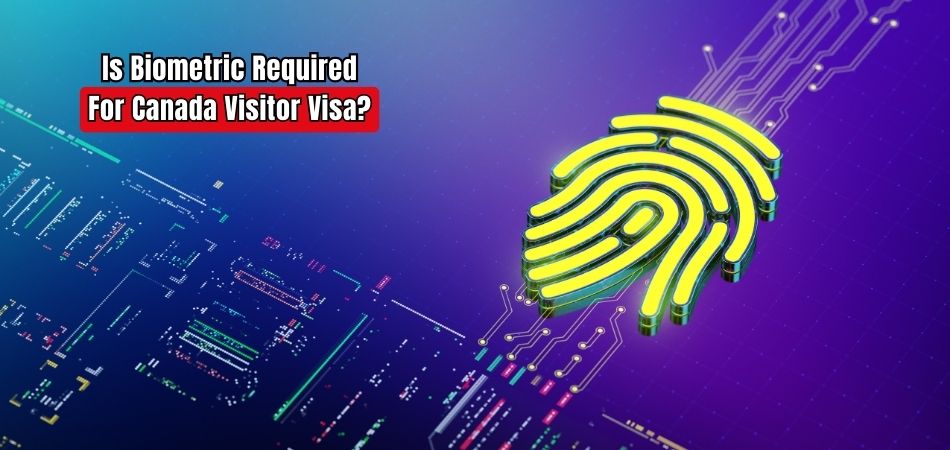The visa application process relies heavily on identity verification to ensure only genuine applicants are approved. Biometrics, including fingerprints and photos, significantly increase the accuracy and security of identity checks.
This modern technology reduces the risk of fraud and streamlines visa applications. But what about the Canadian visitor visa? Is biometric required for Canada visitor visa?
Yes, biometrics are generally required for Canadian visitor visas. The application process requires fingerprints and a photo, which aid in identity verification and strengthen security.
To learn more about the biometric requirements, how to submit them, and other essential details for your Canada visitor visa application, continue reading the rest of the article.
What is the Role of Biometrics in Visa Processing?
The use of biometrics plays a crucial role in enhancing visa processing security. It is easier for authorities to verify identities by requiring fingerprints and photographs. For instance, the visa biometrics procedure employs these checks to ensure thorough identity verification. This step significantly reduces the risk of visa fraud and misuse, making it a vital component in maintaining border security.
For example, when applicants undergo the Canada visa biometrics procedure, their biometrics are checked against global databases to identify any potential security threats. This step ensures that individuals with adverse records or prior visa violations are flagged. It serves as a crucial layer of security, safeguarding both the country and other travelers by preventing unauthorized entries.
The use of biometrics also speeds up the visa application process at entry points. Automated systems match biometrics with visa records, allowing for quicker verification. This technology ensures a smoother and more efficient entry for travelers, reducing wait times and enhancing the overall travel experience.
Is Biometric Required for a Canada Visitor Visa?
Yes, biometrics are indeed required for a Canada visitor visa. This mandatory step involves submitting fingerprints and a photograph as part of the application process. The visa issuance system must be strengthened in order to enhance security and efficiency.
Enhanced Security Measures
Biometrics provide a reliable method to verify identities. This technology helps in detecting and preventing identity fraud. It ensures that each visa is issued to the correct person. Security at borders becomes tighter and more foolproof as a result.
Streamlined Processing
The integration of biometrics speeds up the visa verification process. Automated systems quickly match biometric data with applicant records. The processing time for Canada visitor visa after biometrics is typically reduced, as this step helps eliminate the need for extensive manual checks. Faster processing times lead to quicker visa approvals.
Improved Accuracy in Applicant Screening
Biometrics reduce human errors in the screening process. Accurate identity verification means fewer mistakes in visa issuance. This leads to a more trustworthy and dependable system. It ensures all travelers meet the entry criteria without confusion.
Database Integration
Biometric data is stored in international security databases. This integration helps track and monitor entries and exits across borders. Authorities can easily access and share crucial information. Enhanced database capabilities aid in global security efforts.
Reduced Visa Fraud
Biometrics make it extremely difficult to forge or tamper with visa documents. The unique nature of each individual’s biometric data acts as a deterrent against fraud. This adds an additional layer of security to the visa process. As a result, visa integrity is upheld.
Increased Efficiency at Ports of Entry
Upon arrival, biometrics allow for quick identity confirmation. Travelers experience shorter wait times at immigration checkpoints. This contributes to a smoother, more pleasant travel experience. It also helps in managing the flow of visitors more effectively.
Who Needs to Provide Biometrics for a Canada Visitor Visa?
When applying for a Canada visitor visa, providing biometrics is a key part of the process for most applicants. Biometrics, which include fingerprints and photographs, help in verifying identities and maintaining security. Here’s an overview of who needs to provide biometrics for a Canada visitor visa:
- First-time applicants: Anyone applying for a Canada visitor visa for the first time must provide biometrics. This includes fingerprints and a facial photograph.
- Previous visitors: If it has been over ten years since last providing biometrics, they must be resubmitted. This ensures that the biometric data remains up to date.
- Parents and grandparents: Applicants for a super visa, primarily parents or grandparents of Canadian citizens, require biometrics. This is part of the extended visitor visa process.
- Students and workers: Those applying for student or work visas also need to submit biometrics. This aligns with the requirements for most temporary resident visas.
- Refugee claimants: Individuals claiming refugee status must provide biometrics. This helps in their identification and the processing of their claims.
- Transit travelers: Travelers passing through Canada on their way to another destination need to provide biometrics. This applies if they come from countries with a visa requirement for transit.
How to Submit Your Biometric Information for a Canada Visitor Visa?
Submitting biometric information is a crucial step in obtaining a Canada visitor visa. This process improves the integrity of Canada’s visa program and ensures the security of its borders. Here’s a straightforward guide on how to provide your biometrics efficiently and effectively:
Step 1: Schedule an Appointment
Visit the official website of the Canadian visa application to find your nearest visa application center (VAC). Schedule an appointment for biometric submission as per your convenience. It’s advisable to book early to avoid delays, especially during peak travel seasons.
Step 2: Prepare Necessary Documents
Ensure you have all required documents before your appointment. This typically includes your passport, appointment letter, and visa application confirmation. Double-check the expiration dates and the validity of your documents to prevent any issues at the center.
Step 3: Attend Your Appointment
Arrive at the VAC on time for your scheduled appointment. Late arrivals may need to reschedule, potentially delaying your visa application. Remember to bring your appointment confirmation and identification, and wear appropriate attire for a photograph.
Step 4: Provide Your Biometrics
At the VAC, you will be asked to provide your fingerprints and have your photograph taken. This process is quick and staff at the center will guide you through each step. Ensure your fingers are clean and free of any forms of ink or stains, and your face should be clearly visible for the photograph.
Step 5: Pay the Biometric Fee
There is a fee associated with biometric data collection. This can be paid at the VAC during your appointment. Payment methods vary, so check in advance what is acceptable at your specific center, including credit cards or cash.
Step 6: Receive a Biometric Instruction Letter
Once your biometrics are submitted, you’ll receive a biometric instruction letter confirming that your biometrics have been collected. Keep this letter; it may be required later in your visa application process. Additionally, this letter serves as an official record of your compliance with the biometric requirements.
What Happens if You Don’t Provide Biometrics?
Biometrics are essential in the visa application process, serving as a key security measure. Failing to provide them can complicate or halt your travel plans. Before skipping this step, it is crucial to understand the consequences.
Delayed Processing of Visa Application
If you don’t provide biometrics, your visa application will not be processed. The application will remain incomplete until you fulfill all requirements. This delay can significantly alter your travel schedule. It’s crucial to comply promptly to avoid such setbacks.
Possible Visa Application Rejection
An incomplete application, lacking biometrics, often leads to outright rejection. Without biometrics, the consular officers cannot perform necessary security checks. This is seen as a failure to comply with visa regulations. A rejection can also affect future visa applications negatively.
Ineligibility for Expedited Services
Without biometrics, you become ineligible for any expedited or priority visa processing options. These services require complete documentation, including biometric data. Missing biometrics means missing the chance for faster processing times. Always complete every step to take advantage of available services.
Legal Complications at Entry Points
Arriving at a border without having provided the necessary biometrics can lead to legal issues. You may be held at the border for additional screening. This can include a detailed interview or a return to your home country. Compliance with biometric requirements simplifies entry.
Impact on Future Travel
Failure to provide biometrics can be recorded in your travel history. This may impact your ability to obtain visas in the future. Authorities might view it as non-compliance with immigration requirements. It’s advisable to follow through with all requested steps to ensure smoother future travels.
Tips to Speed Up Canada Visa Processing Time After Biometrics
When applying for a Canada visa, waiting for approval can be stressful, especially after completing biometrics. Fortunately, there are ways to speed up the process. By following these tips, you can help ensure a smoother, faster application experience.
- Submit Complete Documents Early: Providing all required documents at the start helps avoid delays. Missing paperwork can increase the Canada visitor visa processing time after biometrics procedure.
- Double-Check Your Application for Accuracy: Reviewing your application for errors ensures everything is correct. Incorrect details can lead to longer processing times.
- Pay the Required Fees Promptly: Paying your visa application fees on time prevents unnecessary delays. Delayed payments can slow down the approval process significantly.
- Track Application Status Regularly: Keep an eye on your application status through the IRCC portal. Regular tracking helps you address any updates quickly.
- Respond Quickly to Requests for More Information: If the visa office asks for additional details, submit them immediately. Prompt responses help keep your application moving forward.
- Use a Reliable Internet Connection for Submissions: Ensure a stable connection to prevent submission errors. A failed upload can slow visa application processing.
- Opt for Email Notifications for Updates: Set up email notifications to receive real-time updates. This ensures you’re aware of any changes or additional requirements.
- Consider Professional Assistance if Needed: Hiring a visa consultant can help you avoid common mistakes. Professionals can also offer insights to expedite the process.
FAQs About Is Biometric Required for Canada Visitor Visa?
Biometrics have become a fundamental requirement for many visa applications worldwide, including for Canada. They enhance security measures and help in faster processing of applications. Below are ten additional FAQs related to the requirement of biometrics for a Canadian visitor visa.
What if My Biometrics Change Due to Surgery or Injury?
Inform the visa office if you undergo significant changes affecting fingerprint or facial recognition due to surgery or injury. You might need to resubmit your biometrics for accurate records. Always update your information to avoid entry issues at Canadian borders.
How Long Are My Biometrics Valid for a Canada Visitor Visa?
Biometrics for a visitor visa are valid for ten years from the date of collection. You don’t need to resubmit them for subsequent applications within this period. Check the expiration to ensure compliance before any new applications.
Are Children Required to Provide Biometrics?
Children under the age of 14 are not required to provide biometrics for a Canadian visa application. This exemption applies to all minor applicants to simplify the process for families. Parents or guardians should still submit their biometrics as required.
What Happens to My Biometric Data After I Leave Canada?
Biometric data is stored securely by Canadian authorities and used for entry verification purposes only. It’s handled according to strict privacy laws and regulations. Data is used strictly for security and administrative purposes, ensuring privacy.
How Can I Track the Status of My Biometric Submission?
You can track the status of your biometric submission through the online application portal provided by Canadian Immigration. Check your application status regularly for updates. Contact the visa application center if you need assistance with tracking.
Bottom Line
The Canadian visitor visa process emphasizes the significance of biometrics for identity verification. By providing fingerprints and photos, applicants contribute to heightened security measures that prevent identity fraud and ensure accurate screening.
So, is biometric required for Canada visitor visa? Absolutely, it is a vital component for everyone seeking entry into Canada, from first-timers to those needing to update their records after a decade. This step safeguards both the applicant and national security.
Non-compliance with biometric requirements can lead to substantial setbacks, including delayed processing or even visa denial. Applicants should adhere to these guidelines to facilitate a smooth travel experience and uphold the integrity of Canada’s immigration system.








